


 |
September 29-30, 2016: A Trip to the Wichita Mountains |
 |
September 6-10, 2016: The Ruckmans Visit Dallas |
 |
Return to the Index for 2016 |
On September 19th, our friend Guy arrived in Dallas on his way from Massachusetts back down to San Antonio. He had time to spend Tuesday, September 20th with us before heading on down to San Antonio on Wednesday. So we planned a day down in the Dallas Arts District and at Klyde Warren Park. We had just shown the park to Prudence, Nancy and Karl a couple of weeks ago, but Guy had never been there. On the way downtown, we stopped for some lunch.
|
We also thought this would be a good opportunity to stop in at the Dallas Museum of Art, and, as it turned out, there were some exhibits that really caught Guy's interest.
We found a parking place right near Klyde Warren Park, and we stopped in to have some lunch at a restaurant just across the street from the park- a place called Lark on the Park. When we were finished, we walked across the street to the new park. The concept of building a deck park over Woodall Rodgers Freeway may have originated in the 1960s when Dallas Mayor J. Erik Jonsson decided to recess the freeway.
|
The park deck is a feat of engineering and design. It had to be at street level yet preserve clearance for the highway below. An ingenious arrangement of more than 300 concrete beams and a large number of support members have created a solid deck for the park. They also created a series of gigantic "planter boxes," suspended over the freeway, that are large enough that small trees can be planted in them.
We came into the park pretty much in the middle, and walked to the east side where there is a long walkway bordered by trees and framed by decorative semi-arches. The view at right looks north from the middle of the park. A number of food trucks park to the right out of this picture.
From the vantage point in the picture above, we walked to the end of the arched arbor, and this brought us to the northeast end of the park, and from there you could see the Woodall Rogers Freeway heading north after going underneath the park. To the left, looking along Pearl Street towards the northwest, you can see the Dallas branch of the Federal Reserve on the north side of the street, and a new office structure going up on the other side of the street.
|
|
We walked southeast along Pearl Street towards Ross Avenue. Once we passed the Museum Tower, we could see a good deal of downtown Dallas, and some of the closer skyscrapers.
In the composite picture at right, stitched together from three separate pictures, you can see the Chase/Deloitte Building at the left; this building is also locally known as the Keyhold Building (for obvious reasons). Then you can see Guy and Fred standing on the south side of Pearl Street. Next are some office towers and other buildings in the distance, and then the Trammell Crow Tower just a block away. This tower houses the Trammell Crow real estate empire, and also his collection of Asian Art. To the right are more buildings in downtown Dallas, including the top of the angular Fountain Place Tower. Museum Tower is just out of the picture to the right.
There is a new building going up just between the Meyerson Symphony Hall and the Freeway; I am not sure what it is going to be. We are going to head over towards Symphony Hall.
|
|
The Nasher Sculpture Center and the DMA are off to our right, and we'll visit them a bit later.
So we continued a bit along Pearl Street and then turned left onto Flora Street- just this side of the Cathedral Shrine of the Virgin of Guadalupe- and this took us along the front of the Meyerson Symphony Center. We are going to walk northeast along Flora to see the sculptures at the base of 2323 Ross. Here are some of the pictures taken along Flora St. in front of the symphony hall:
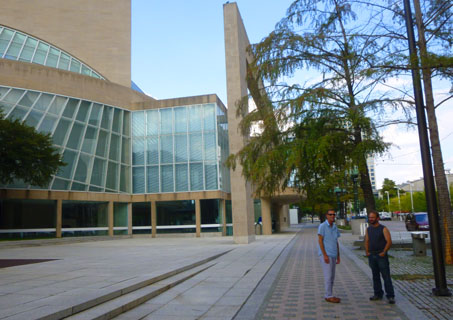 Here are Guy and Fred standing just to the south of the main entrance to the Meyerson Symphony Center- a building very familiar to Fred and I from our long-standing subscription to the Symphony. |
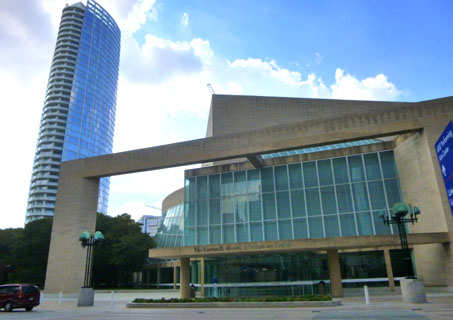 Taken a bit later from across Flora St., this view of the Meyerson looks back towards Klyde Warren Park, and you can see the new Museum Tower beyond it. |
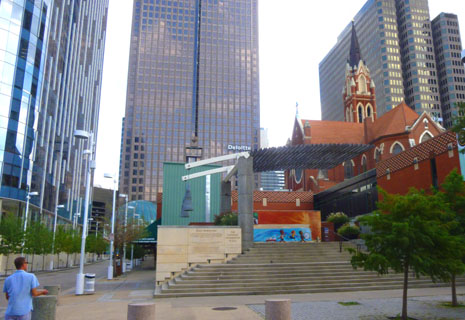 Across Flora from symphony hall the Cathedral has constructed an elevated patio- presumably for church functions. It is neat, looking out over the Arts District from the top of the stairs. |
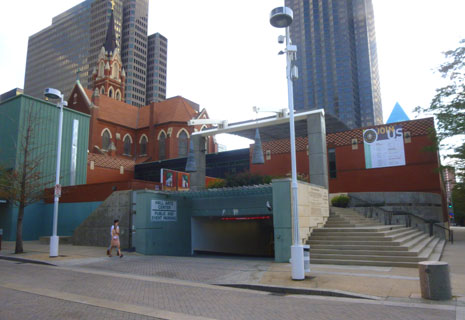 Here is Guy looking up at the patio, which also has a few sculptural pieces put there by the church. There is a parking garage under this portion of the cathedral property. |
From the front of the Symphony Hall, here are a couple of pictures looking up Crockett Street towards Ross Avenue:
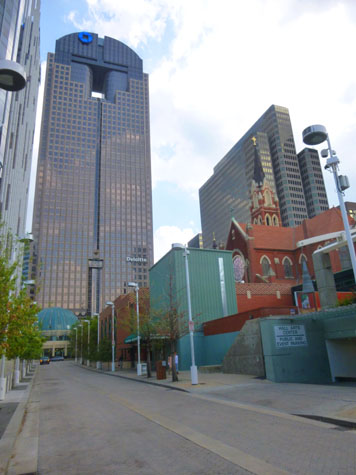 |
(Picture at left) Here is a view up Crockett Street looking towards the Deloitte/Chase building, with the cathedral off to the right.
(Picture at right)
|
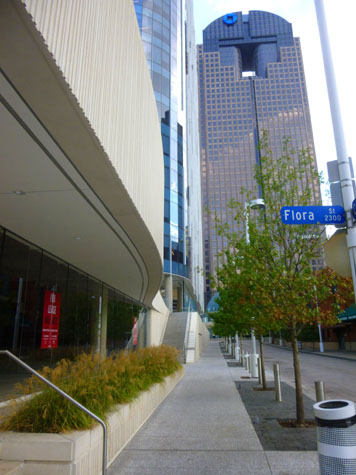 |
We continued walking along Flora St. until we could come around the far side of the new building at 2323 Ross Avenue; we wanted to show Guy all the sculptures that have been installed at its base. On the ground floor of this building, opening onto Flora St., restauranteur Stephen Pyle is opening a new restaurant, and I noticed that someone was photographing one of the dishes- presumably for the menu or for advertising. As I brought up my camera to take a picture of the process, the photographer noticed me and turned to take his own picture of me.
The new building at 2323 Ross Avenue houses a number of businesses- the largest being the Dallas offices of Jackson-Walker, a large law firm, and KPMG, an international professional services company. I don't know whether one of the building's tenants commissioned the addition of all the outside sculpture, or whether the building's owners did, but we walked around the base of the building looking at all of it.
|
|
From the northeast side of the new office tower at 2323 Ross Avenue, we came out on Ross Avenue and then started walking southwest back towards the Dallas Museum of Art. In front of this new office tower I got what I thought was an interesting view looking directly up the side of the building at its main entrance. You can see that picture here. Across the street are some of Dallas' newer office towers, including the Deloitte/Chase building. The circular domed building in the front plaza of that building has always been interesting. It seems as if at one time it was an event space for the building, but at the moment it seems to be some kind of exercise facility. It adds a good deal of interest to the area, though.
|
In 1869, Dallas's first Catholic parish, Sacred Heart Church, was established by the Bishop of Galveston. The church was built in 1872 and was located at Bryan and Ervay Streets, near present-day St. Paul Station. In 1890, Dallas was established as a diocese, and Sacred Heart became the diocesan cathedral of Dallas with Bishop Thomas Brennan acting as the first bishop. Along with Dallas' tremendous growth at the time, the parish soon outgrew its church building, and the need for a new cathedral arose.
The property on which the current Cathedral is now located was purchased for $30,000, which adjusted for inflation, is equivalent to over $600,000 in 2007.
|
The parish, located on Harwood Street, was established in 1914 and primarily served Mexican immigrants. Bishop Thomas Tschoepe of Sacred Heart invited Our Lady of Guadalupe to merge with Sacred Heart, and by 1975, the Guadalupe church on Harwood closed following the churches' consolidation. On December 12, 1977, Sacred Heart Cathedral was renamed Cathedral Santuario de Guadalupe — "the Cathedral Shrine of Our Lady of Guadalupe." This reflects the large Spanish-speaking proportion of the congregation, so that the congregation now has masses and various programs in Spanish and English, as well as English classes.
The Cathedral recently underwent a major multi-phase renovation project. As part of the project, a $20 million bell tower housing a 49-bell carillon was constructed. The bell tower was planned by the original architect, Nicholas J. Clayton, but was never built.
I've always thought that the front entrance of the church was particularly pretty- especially for a church that it not, itself, particularly large or grand. You can see a close-up view of the entrance here.
We continued walking southwest along Ross Avenue, and as we crossed Pearl Street, we had another nice view of Museum Tower looking towards Klyde Warren Park.
|
He married 22-year-old Nettie Ennis in 1868; she was the daughter of a former Houston mayor. They had two children- Jeanette and Alfred Horatio, Jr. In 1881, editor Willard Richardson died, and the company became known as A.H. Belo & Co. That year, Belo sent employee George Dealey to North Texas to set up a satellite edition of the Galveston paper; The Dallas Morning News was established in 1885, and Belo moved to Dallas that same year to become the fledgling newspaper's publisher.
In 1888, Nettie Ennis Belo bought a brown frame house at the corner of Ross Avenue and Pearl Street. Ross Avenue became the first elegant address in Dallas and its first paved street. Architect Herbert Miller Greene was commissioned to design a stately mansion, and construction was believed to have been completed about 1900. Alfred Horatio Belo, Jr. married in 1900; he and his wife lived in the mansion with his parents. The Belo home became a city showplace, as the family was active in civic and cultural affairs.
Colonel A.H. Belo died in 1901 at the age of 69 and was buried in Winston-Salem, NC, near his boyhood home. His close friend, President Grover Cleveland said, "He was a chivalrous, high-minded man, and an exceptionally able, fearless and conscientious journalist. His death is a loss to the entire country.” Alfred, Jr. succeeded his father at the newspaper, but he died in 1906 of meningitis. Colonel Belo’s widow lived in the home with her daughter-in-law, Helen Ponder Belo, and two granddaughters until her death in 1913 at the age of 67. In 1922, Helen was forced to leave Dallas and move to North Carolina because of ill health, marking the end of occupancy of the mansion by the Belo family after only 21 years. After the departure of the Belo family, the house was leased for 50 years as a funeral home, and at the end of the lease, Belo's granddaughter sold the property to the Dallas Bar Association.
|
Around the base of this building, which inside houses the Crow Collection of Asian Art, there is a small park, in which have been placed some of the larger sculptures in the Crow Collection. We walked around the building, looking at these sculptures and garden features, and some of the pictures we took are below:

(Click on Thumbnails to View) |
We walked around the building back to Flora Street. There, there is an upper-level mezzanine patio, with nice planted areas, some fountains and neat views to the northeast and southwest. Here are the two pictures I took there:
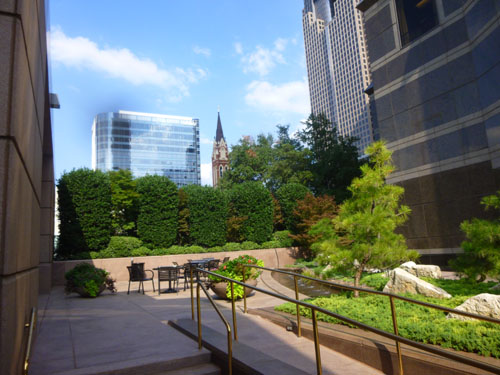 Looking Northeast |
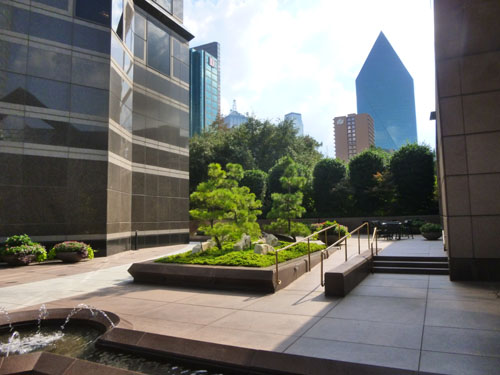 Looking Southwest |
Going from this upper-level garden, there are dual stairways down to Flora Street and the entrance to the Crow Collection. Right in the middle of these stairs is a really neat waterfall.
|
|
(Mouseover Image Above for Video Controls) |
Back down on Flora Street, we walked the half-block over to the Dallas Museum of Art, coming into the building from the Harwood Street entrance, where there is another neat fountain. The DMA, like the museums in Fort Worth, has free admission to the permanent collection, although special exhibits often have a fee. Today, we just decided to wander through a few of the galleries and walk up and down the main hall of the museum complex that extends from the Ross Avenue entrance to the entrance from Klyde Warren Park.
Guy was interested in the exhibits of American Art and furnishings, so that was where we spent most of our time. I photographed a number of pieces of artwork and some of the furnishings, and also took some pictures along the main hall- including a couple of the incredibly colorful mural that lines one section of the main hall. I didn't photograph the artist attributions, so the pictures can just speak for themselves. But I did think you would like to see the works of art, so I have two slide shows for you, and they are below. Use the arrows in the lower corners of each picture to move through the show, and track your progress with the number in the upper left corner of each picture.
|
|
We enjoyed walking through some of the galleries in the DMA, and we enjoyed walking around the Arts District with Guy. When we were done at the museum, we headed home, and Guy left the next morning to finish his trip down to San Antonio. We did make plans for him to return in a week to take a trip with us up to the Wichita Mountains.
You can use the links below to continue to another photo album page.
 |
September 29-30, 2016: A Trip to the Wichita Mountains |
 |
September 6-10, 2016: The Ruckmans Visit Dallas |
 |
Return to the Index for 2016 |